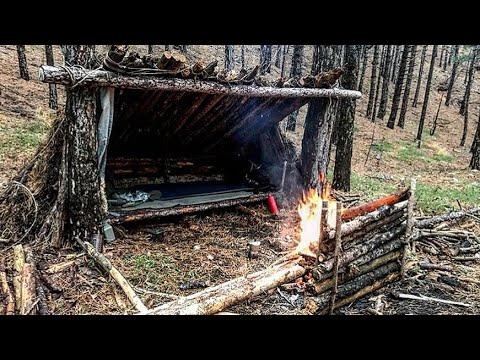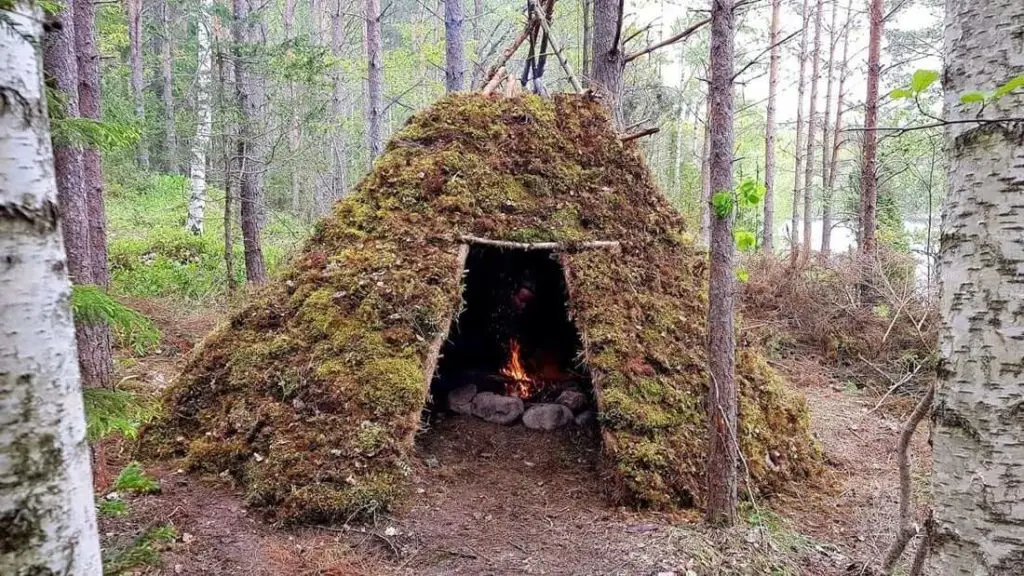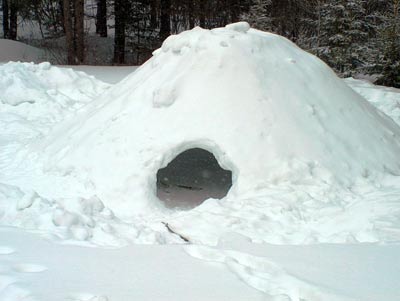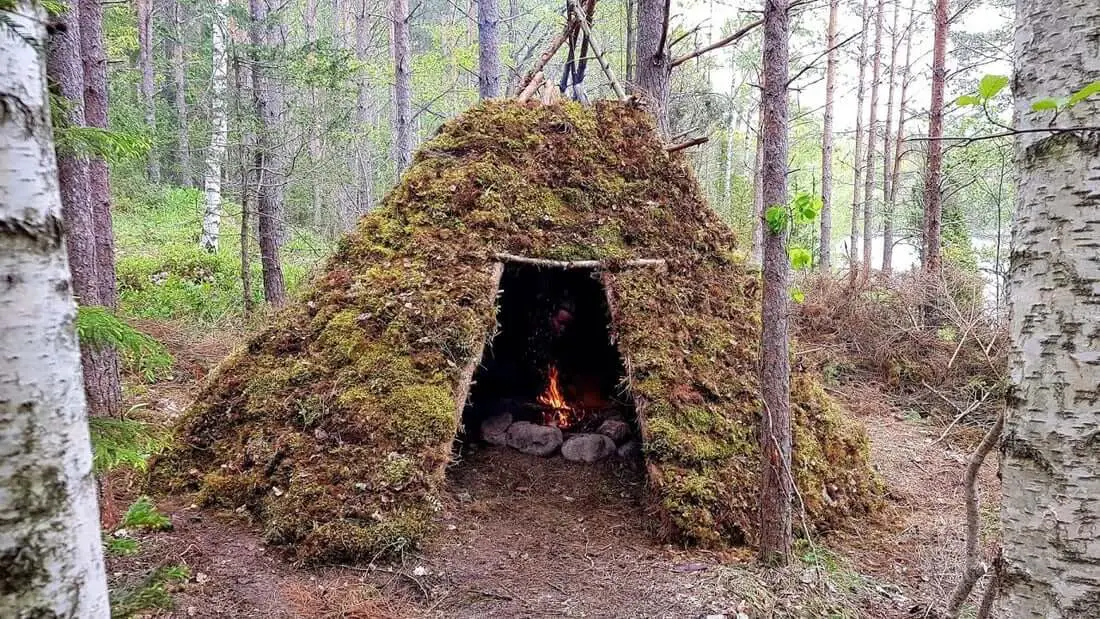Building a long-term survival shelter is a skill that any survivalist or prepper should have.
It doesn’t matter if there’s a disaster, SHTF scenario, or you simply got into a bit of trouble while camping. This kind of shelter can help you survive (and thrive) no matter what.
While being able to get a fast shelter up and running is a great skill to have in the short term, building a long term survival shelter is the natural next step. It doesn’t take as much time as you think and the difference it makes in the wilderness is huge.
In this guide, we’ll cover the essentials of long-term survival shelters and how to set them up. You’ll learn tested build designs and what to look out for when picking a spot.










Table of Contents
Options For Long-Term Survival Shelter
There are a number of options when it comes to building a long term survival shelter. Some are better for certain situations in the wilderness than others (snowy conditions for example), while others might just appeal to you a little more.
While there are significant differences from a lot of the types on our list, they’re all extremely efficient and have been relied on forever. Understanding the advantages and disadvantages of each is useful, but in most situations just getting something up is the name of the game.
Lean-To
This is one of the most popular forms of long term survival shelter so we wanted to include it first. It’s a relatively simple design that doesn’t take a whole lot of energy to build. It’s also great at providing radiant heat that comes in from your fire.


You can build a quick version of this with something like a tarp or emergency blanket, but for the purposes of this article, we’ll dig into the more sturdy version.
The best way to approach this shelter is by locating two sturdy trees that are fairly close to each other. These will serve as the foundation that you’ll build your lean-to on. If you pick weak or dead trees there’s a chance that the shelter won’t last very long.
Next up, take a thick piece of wood (you might need to do some cutting to get the perfect piece) and tie it to the two trees at roughly chest height so it’s parallel to the ground. This will be where you lean the roof of your shelter on.
Sometimes you can find two trees that have natural wedges for this support beam, but that’s rather rare. You don’t want to burn light and energy looking for the perfect two trees that might not exist for miles.
Now that you have the main foundation of your lean-to set up, it’s time to build the rest of your long term survival shelter. If possible you’ll want to build a simple floor by laying long and thin pieces of wood/sticks on top of a few larger pieces. This will help you stay dry and warm.
At this point, you should set up the roof. The roof of a lean-to is quite simple, but you can get quite fancy with it if you want. In its essence, you’ll be taking plenty of long sticks and leaning them at a 45-degree angle against the support beam you’ve tied to the trees.
Once you have a well-covered roof, pack it with leaves and vegetation to prevent water and heat from coming in and out. Tying these pieces of wood together with some paracord will make it even more secure.
- Extra 200 pounds of strength beats regular 550 cord
- Versatile and perfect for setting up a survival shelter
- Tough as nails while soft and flexible
- Cord is never spliced and is made entirely in the USA
All that’s left is to set up a fire in front of it with a wooden back wall to send as much heat as possible in your direction. This standard setup is an extremely effective long term survival shelter that will keep you going in even the worst conditions.
Teepee
The teepee is another long term survival shelter that has been used by humans for thousands of years. It’s a simple and extremely effective way to protect yourself from the elements without getting too fancy.


While you can build a simple teepee by simply finding a bunch of long sticks and leaning them against each other, that’s not very sturdy. The more long term approach involves putting more effort into the foundation so it won’t fall apart on you as time goes by.
Three long sticks tied together at the top will serve as the base of the teepee. From there, find three much smaller sticks and tie them along each side of the pyramid formed at the top of the teepee. This will reinforce the base of your shelter and provide much more security than the simple “lean and pray” method you see people build for fun along hiking trails.
These will also serve as reliable surfaces to lay the wall of your structure on. It’s quite east to rest a bunch of long sticks along a flat surface than the alternative. Do this on each side until you’re satisfied with the coverage.
Now that you have your walls you can pack it with vegetation and debris to keep heat from leaving, and water from coming in.
There are a couple of variations you can make with this foundation. One would have you keep an opening at the top so you can have an inside fire and space for smoke to escape. The other is more of a standard closed roof design where you have your fire near the opening.
Anything With Tarp
We would be remiss if we didn’t cover the most magical survival material out there, tarp. There are a million shelter variations you can make with a tarp, which is why it’s loved by so many survivalists.
- Great for covering items or placement under a camping tent
- Reinforced corners and edges for long-lasting strength
- Made of durable rip-stop fabric with polyethylene lamination on both sides
- Rugged rust-resistant grommets along the outer edge for securely tying down the tarp
You can make a lean-to, a teepee, a DIY survival tent, and a ton of other forms of shelter with some tarp and a little bit of paracord. While many people don’t think of it as something capable of building a long-term survival shelter, we disagree.
You can use a hybrid approach of tarp and stronger foundational structures like wood to create a very respectable wilderness survival shelter that can stand the test of time. This can be by doubling up in certain areas to maximize dryness and heat retention, or by expanding to build something a little more elaborate.
For example, you could build a standard teepee with wood and then use the tarp to quickly construct a lean-to, making your very own wilderness survival compound. Or you could take a piece of the tarp to fortify the top of a teepee and use the other part to layer your floor more effectively.
To put it simply, when it comes to building a shelter a little bit of tarp can go a long way.
Quinzhee
If you’re in a snowy environment then a quinzhee is a great choice for you. Depending on the weather situation it can definitely be a long term survival shelter, but that’s not guaranteed (warm weather will impact this obviously).


A quinzhee is basically a large pile of snow that you hollow out in the middle so it can be used for shelter. Snow is an incredibly effective insulator and this way of using it is something that anyone can learn.
The first thing you’ll need to do is build your big mound of snow. This should be large enough to fit you comfortably when lying down. We’ve seen some people build rather large and spacious quinzhees, but that’s not necessary for a survival situation. Space for yourself and your gear will do (you’re not going to be building a fire inside it or anything).
Once you have your pile of snow you should wait at least 90 minutes for it to set and harden. If you can spare some extra time just to be safe that’s always a good idea. This time can be spent building a wind wall for your fire or looking for fuel.
After the recommended period of time has passed it’s time for you to dig out the center of your quinzhee. There’s a little more to it than you might think, so pay close attention to these steps. Some very minor changes can make this a bit more of a long term wilderness shelter than a one-night wonder.
First, dig the opening a bit lower than the floor area where you’ll be sleeping. This will make a big difference in the amount of heat the interior retains. Dig down into the snow and then up into the main space a bit before leveling off.
It might be a pain, but do what you can to eyeball the thickness you’re leaving in the walls. Go outside periodically to check and see where you’ve been digging (it can be easy to get carried away or lose track of where you are inside).
Thin walls won’t insulate as well and are far more prone to collapse. If you want to get as much mileage out of this as you can, make sure the walls are nice and thick.
Take some brush or vegetation like pines and place it on the floor of your shelter to help you stay warm when sleeping. If you have something like a tarp that can be used as well (as well as for blocking the opening).
Existing Shelter Options
This section is reserved for some of the best long term survival shelters out there, natural ones. Things like caves, overhanging cliffs, spots underneath large boulders (stable ones), or massive trees are all good examples of this.
The reason these are so great is they’ve already been around for a while and are typically way stronger than anything you can whip up in a night. You can also use some of your own shelter tricks to build something that compliments natural shelter (a lean-to inside a large cave for example).
While many situations won’t have the perfect natural spot waiting for you, you should make it a habit to keep an eye out for them anyway. Spotting one can save you a lot of time and give you the perfect long term survival shelter in the wilderness that requires zero building.
Thinking Past The Structure
Now that you know some great structures that will keep you out of the elements, it’s time to go one step further. There are a number of things you should consider when building a long term survival shelter that many people overlook.
These can significantly impact your chance of surviving in the wilderness for an extended period of time. So don’t forget them!
Proximity To Water
Water is obviously one of the most important pieces of the puzzle when it comes to survival. If you don’t have water, you’re not getting very far.
That’s why when building a long term survival shelter you should make sure you have a nearby water source. If you can keep the source of water no more than 200 feet away from your shelter that’s ideal.
It should also be an easy walk to get to the water source if possible. You don’t want to burn a ton of energy each day making the trip.
Exposure To The Elements
There are other factors to consider when it comes to the placement of your shelter in the wilderness. The amount of stress and exposure to the elements that the structure will face is a big one.
Being aware of the wind direction is something that many people don’t think about. Depending on where you position your shelter, wind can cool down the interior or blow smoke and water inside.
You should also do an assessment of the surrounding area to make sure there you’re not setting up somewhere dangerous. Loose rocks, flood zones, and dead trees should be avoided at all costs.
Fuel For Fires
Having a fire going is essential when it comes to your survival. That means you’ll need fuel nearby in order to keep it going.
The principles of this rule are the same as with the proximity to water. You don’t want to spend a ton of time and energy hiking to get enough wood to burn. There should be plenty of fuel within a relatively short walk of your shelter.
Distance To A Fishing Spot
If you’re truly building a long term survival shelter you’ll likely need to do some fishing eventually. Keep this in mind when scouting out sources of water, because it might make the difference between a decent spot and a great one.
Fast-moving water near some rapids is ideal if you can find it. Depending on your fishing skills and knowledge of the area, identify the most suitable spot to catch fish and set up shop nearby.
Bathroom Area
For this, you’ll want to follow a lot of the same principles as you would with an emergency toilet. This means keeping the bathroom area at least 100 feet away from your main source of water and where you prepare your food (the more the better).
This will keep you from getting sick because your water will stay clean, and insects attracted to waste won’t find your food.
Putting It All Together
Learning how to build a long term survival shelter is not as tricky as it seems. Once you know how to build a couple of the main types, you’re in pretty good shape.
However, don’t forget about the other principles of your shelter area as well. Proximity to water and being in a generally well-positioned area can make just as much of a difference as a well-made structure.
The concept of creating a long term survival structure and putting it to the test is something that we’re very interested in. As we continue to develop the site we will add more info to support this process, and even do some gear reviews on essential things you’ll need to bring to the wilderness.
If you have any questions about this article or want to share your own experiences, we’d love for you to weigh in! Simply reach out to us via the email address on our contact page and we’ll respond as fast as we can.


